Applying Force Plate Technology to Inform Human Performance Programming in Tactical Populations
Abstract
1. Introduction
2. Important Data Considerations for Implementing Force Plate Testing
3. Profile Testing for Physical Capabilities
3.1. Use of Loaded Jump Assessments
3.2. Creating Normative Data and Percentile Scores
3.3. Case Study Scenario 1: Profiling
4. Testing Performances for Training Related Adaptations
Case Study Scenario 2: Training Adaptations
5. Testing to Monitor Neuromuscular Fatigue and Detraining
Case Study Scenario 3: Monitoring Neuromuscular Fatigue
6. Monitoring Force Asymmetries
7. Conclusions
Author Contributions
Funding
Institutional Review Board Statement
Informed Consent Statement
Data Availability Statement
Conflicts of Interest
References
- Kyröläinen, H.; Pihlainen, K.; Vaara, J.P.; Ojanen, T.; Santtila, M. Optimising training adaptations and performance in military environment. J. Sci. Med. Sport 2018, 21, 1131–1138. [Google Scholar] [CrossRef] [PubMed]
- Maupin, D.; Schram, B.; Orr, R. Tracking training load and its implementation in tactical populations: A narrative review. Strength Cond. J. 2019, 41, 1–11. [Google Scholar] [CrossRef]
- Lyons, K.; Radburn, C.; Orr, R.; Pope, R. A profile of injuries sustained by Law Enforcement Officers: A critical review. Int. J. Environ. Res. Public Health 2017, 14, 142. [Google Scholar] [CrossRef]
- Taylor, N.A.; Dodd, M.; Taylor, E.; Donohoe, A. A retrospective evaluation of injuries to Australian Urban Firefighters (2003 to 2012): Injury Types, Locations, and Causal Mechanisms. J. Occup. Environ. Med. 2015, 57, 757–764. [Google Scholar] [CrossRef] [PubMed]
- Wardle, S.L.; Greeves, J.P. Mitigating the risk of musculoskeletal injury: A systematic review of the most effective injury prevention strategies for Military personnel. J. Sci. Med. Sport 2017, 20, S3–S10. [Google Scholar] [CrossRef] [PubMed]
- Bullock, S.H.; Jones, B.H.; Gilchrist, J.; Marshall, S.W. Prevention of physical training–related injuries: Recommendations for the Military and other active populations based on expedited systematic reviews. Am. J. Prev. Med. 2010, 38, S156–S181. [Google Scholar] [CrossRef] [PubMed]
- Kaufman, K. Military training-related injuries surveillance, research, and prevention. Am. J. Prev. Med. 2000, 18, 54–63. [Google Scholar] [CrossRef]
- Knapik, J.J.; Graham, B.S.; Rieger, J.; Steelman, R.; Pendergrass, T. Activities associated with injuries in initial entry training. Mil. Med. 2013, 178, 500–506. [Google Scholar] [CrossRef] [PubMed]
- Dijksma, C.I.; Bekkers, M.; Spek, B.; Lucas, C.; Stuiver, M. Epidemiology and financial burden of musculoskeletal injuries as the leading health problem in the Military. Mil. Med. 2020, 185, e480–e486. [Google Scholar] [CrossRef]
- Knapik, J.J.; Grier, T.; Spiess, A.; Swedler, D.I.; Hauret, K.G.; Graham, B.; Yoder, J.; Jones, B.H. Injury rates and injury risk factors among Federal Bureau of Investigation new agent trainees. BMC Public Health 2011, 11, 920. [Google Scholar] [CrossRef]
- Knapik, J.J.; Sharp, M.A.; Canham-Chervak, M.; Hauret, K.; Patton, J.F.; Jones, B.H. Risk factors for training-related injuries among men and women in basic combat training. Med. Sci. Sports Exerc. 2001, 33, 946–954. [Google Scholar] [CrossRef] [PubMed]
- Ruble, P.; Silverman, M.; Harrell, J.; Ringenberg, L.; Fruendt, J.; Walters, T.; Christiansen, L.; Llorente, M.; Barnett, S.D.; Scherb, B.; et al. Medical and physical readiness of the U.S. Army Reserve for Noble Eagle/Enduring Freedom/Iraqi Freedom: Recommendations for future mobilizations. Mil. Med. 2005, 170, 443–450. [Google Scholar] [CrossRef] [PubMed][Green Version]
- Kelly, E.W.; Bradway, L.F. A Team Approach to the treatment of musculoskeletal injuries suffered by Navy Recruits: A method to decrease attrition and improve quality of care. Mil. Med. 1997, 162, 354–359. [Google Scholar] [CrossRef] [PubMed][Green Version]
- Cunanan, A.J.; DeWeese, B.H.; Wagle, J.P.; Carroll, K.M.; Sausaman, R.; Hornsby, W.G.; Haff, G.G.; Triplett, N.T.; Pierce, K.C.; Stone, M.H. The General Adaptation Syndrome: A foundation for the concept of periodization. Sports Med. 2018, 48, 787–797. [Google Scholar] [CrossRef]
- Nindl, B.C.; Barnes, B.R.; Alemany, J.A.; Frykman, P.N.; Shippee, R.L.; Friedl, K.E. Physiological consequences of U.S. Army Ranger Training. Med. Sci. Sport Exerc. 2007, 39, 1380–1387. [Google Scholar] [CrossRef]
- Trank, T.V.; Ryman, D.H.; Minagawa, R.Y.; Trone, D.W.; Shaffer, R.A. Running Mileage, Movement Mileage, and Fitness in Male U.S. Navy Recruits; Naval Health Research Center: San Diego, CA, USA, 2001; p. 8.
- Nindl, B.C.; Alvar, B.A.; Dudley, J.R.; Favre, M.W.; Martin, G.J.; Sharp, M.A.; Warr, B.J.; Stephenson, M.D.; Kraemer, W.J. Executive Summary from the National Strength and Conditioning Association’s Second Blue Ribbon Panel on Military Physical Readiness: Military Physical Performance Testing. J. Strength Cond. Res. 2015, 29 (Suppl. 11), S216–S220. [Google Scholar] [CrossRef]
- Hauschild, V.D.; DeGroot, D.W.; Hall, S.M.; Grier, T.L.; Deaver, K.D.; Hauret, K.G.; Jones, B.H. Fitness tests and occupational tasks of Military interest: A systematic review of correlations. Occup. Environ. Med. 2017, 74, 144–153. [Google Scholar] [CrossRef]
- Selye, H. The General Adaptation Syndrome and the Diseases of Adaptation. J. Clin. Endocrinol. 1946, 6, 117–230. [Google Scholar] [CrossRef]
- de la Motte, S.J.; Gribbin, T.C.; Lisman, P.; Murphy, K.; Deuster, P.A. Systematic review of the association between physical fitness and musculoskeletal injury risk: Part 2-muscular endurance and muscular strength. J. Strength Cond. Res. 2017, 31, 3218–3234. [Google Scholar] [CrossRef]
- de la Motte, S.J.; Lisman, P.; Gribbin, T.C.; Murphy, K.; Deuster, P.A. Systematic review of the association between physical fitness and musculoskeletal injury risk: Part 3—Flexibility, power, speed, balance, and agility. J. Strength Cond. Res. 2019, 33, 1723–1735. [Google Scholar] [CrossRef]
- West, S.W.; Clubb, J.; Torres-Ronda, L.; Howells, D.; Leng, E.; Vescovi, J.D.; Carmody, S.; Posthumus, M.; Dalen-Lorentsen, T.; Windt, J. More than a metric: How training load is used in elite sport for athlete management. Int. J. Sports Med. 2020. [Google Scholar] [CrossRef] [PubMed]
- Hoffman, J.R.; Chapnik, L.; Shamis, A.; Givon, U.; Davidson, B. The effect of leg strength on the incidence of lower extremity overuse injuries during Military training. Mil. Med. 1999, 164, 153–156. [Google Scholar] [CrossRef] [PubMed]
- Kollock, R.O.; Andrews, C.; Johnston, A.; Elliott, T.; Wilson, A.E.; Games, K.E.; Sefton, J.M. A Meta-analysis to determine if lower extremity muscle strengthening should be included in Military knee overuse injury-prevention programs. J. Athl. Train. 2016, 51, 919–926. [Google Scholar] [CrossRef] [PubMed]
- Orr, R.; Pope, R.; Peterson, S.; Hinton, B.; Stierli, M. Leg power as an indicator of risk of injury or illness in Police recruits. Int. J. Environ. Res. Public Health 2016, 13, 237. [Google Scholar] [CrossRef]
- Daniels, W.L.; Vogel, J.A.; Jones, B.H. Comparison of Aerobic Power and Dynamic Lift Capacity with Performance during a 5-Day Sustained Combat Scenario; Army Research Institute of Environmental Medicine: Natick, MA, USA, 1984. [Google Scholar]
- Dawes, J.; Lockie, R.; Kornhauser, C.; Holmes, R.; Orr, R. Relationships between absolute and relative strength and power in male Police Officers of varying strength levels. J. Sci. Sport Exerc. 2019, 1, 281–288. [Google Scholar] [CrossRef]
- Lockie, R.G.; Moreno, M.R.; McGuire, M.B.; Ruvalcaba, T.J.; Bloodgood, A.M.; Dulla, J.M.; Orr, R.M.; Dawes, J.J. Relationships between Isometric Strength and the 74.84-Kg (165-Lb) Body drag test in Law Enforcement Recruits. J. Hum. Kinet. 2020, 74, 9. [Google Scholar] [CrossRef]
- Muirhead, H.; Orr, R.; Schram, B.; Kornhauser, C.; Holmes, R.; Dawes, J.J. The Relationship between fitness and marksmanship in Police Officers. Safety 2019, 5, 54. [Google Scholar] [CrossRef]
- Lockie, R.G.; Dawes, J.J.; Balfany, K.; Gonzales, C.E.; Beitzel, M.M.; Dulla, J.M.; Orr, R.M. Physical fitness characteristics that relate to work sample test battery performance in Law Enforcement Recruits. Int. J. Environ. Res. Public Health 2018, 15, 2477. [Google Scholar] [CrossRef]
- Moreno, M.R.; Dulla, J.M.; Dawes, J.J.; Orr, R.M.; Cesario, A.; Lockie, R.G. Lower-body power and its relationship with body drag velocity in Law Enforcement Recruits. Int. J. Exerc. Sci. 2019, 12, 847–858. [Google Scholar]
- Mala, J.; Szivak, T.K.; Flanagan, S.D.; Comstock, B.A.; Laferrier, J.Z.; Maresh, C.M.; Kraemer, W.J. The role of strength and power during performance of high intensity Military tasks under heavy load carriage. US Army Med. Dep. J. 2015, 4, 3–11. [Google Scholar]
- Dawes, J.J.; Lindsay, K.; Bero, J.; Elder, C.; Kornhauser, C.; Holmes, R. Physical fitness characteristics of high vs. low performers on an occupationally specific physical agility test for patrol officers. J. Strength Cond. Res. 2017, 31, 2808–2815. [Google Scholar] [CrossRef]
- Kraemer, W.J.; Mazzetti, S.A.; Nindl, B.C.; Gotshalk, L.A.; Volek, J.S.; Bush, J.A.; Marx, J.O.; Dohi, K.; GÓmez, A.L.; Miles, M.; et al. Effect of resistance training on women’s strength/power and occupational performances. Med. Sci. Sport Exerc. 2001, 33, 1011–1025. [Google Scholar] [CrossRef]
- Knapik, J.J.; Harman, E.A.; Steelman, R.A.; Graham, B.S. A Systematic review of the effects of physical training on load carriage performance. J. Strength Cond. Res. 2012, 26, 585–597. [Google Scholar] [CrossRef] [PubMed]
- Pihlainen, K.; Santtila, M.; Häkkinen, K.; Kyröläinen, H. Associations of physical fitness and body composition characteristics with simulated military task performance. J. Strength Cond. Res. 2018, 32, 1089–1098. [Google Scholar] [CrossRef]
- Nindl, B.C.; Castellani, J.W.; Warr, B.J.; Sharp, M.A.; Henning, P.C.; Spiering, B.A.; Scofield, D.E. Physiological employment standards III: Physiological challenges and consequences encountered during international military deployments. Eur. J. Appl. Physiol. 2013, 113, 2655–2672. [Google Scholar] [CrossRef] [PubMed]
- Friedl, K.E.; Knapik, J.J.; Kkinen, K.H.; Baumgartner, N.; Groeller, H.; Taylor, N.A.S.; Duarte, A.F.A.; Jones, B.H.; Kraemer, W.J.; Nindl, B.C. Perspectives on aerobic and strength influences on military physical readiness: Report of an international military physiology roundtable. J. Strength Cond. Res. 2015, 29, S10–S23. [Google Scholar] [CrossRef]
- Gorostiaga, E.M.; Navarro-Amézqueta, I.; Calbet, J.A.L.; Hellsten, Y.; Cusso, R.; Guerrero, M.; Granados, C.; González-Izal, M.; Ibañez, J.; Izquierdo, M. Energy metabolism during repeated sets of leg press exercise leading to failure or not. PLoS ONE 2012, 7, e40621. [Google Scholar] [CrossRef]
- Izquierdo-Gabarren, M.; González de Txabarri Expósito, R.; García-Pallarés, J.; Sánchez-Medina, L.; Sáez de Villarreal, E.S.; Izquierdo, M. Concurrent endurance and strength training not to failure optimizes performance gains. Med. Sci. Sport Exerc. 2009, 42, 1191–1199. [Google Scholar] [CrossRef] [PubMed]
- Merrigan, J.J.; Stone, J.D.; Thompson, A.G.; Hornsby, W.G.; Hagen, J.A. Monitoring neuromuscular performance in military personnel. Int. J. Environ. Res. Public Health 2020, 17, 9147. [Google Scholar] [CrossRef]
- Gajewski, J.; Michalski, R.; Buśko, K.; Mazur-Różycka, J.; Staniak, Z. Countermovement depth–a variable which clarifies the relationship between the maximum power output and height of a vertical jump. Acta Bioeng. Biomech. 2018, 20, 127–134. [Google Scholar]
- Taylor, K.-L.; Chapman, D.W.; Cronin, J.B.; Newton, M.J.; Gill, N. Fatigue monitoring in high performance sport: A survey of current trends. J. Aust. Strength Cond. 2012, 20, 12–23. [Google Scholar]
- Jiménez-Reyes, P.; Samozino, P.; Brughelli, M.; Morin, J.-B. Effectiveness of an individualized training based on force-velocity profiling during jumping. Front. Physiol. 2017, 7. [Google Scholar] [CrossRef]
- Street, G.; McMillan, S.; Board, W.; Rasmussen, M.; Heneghan, J.M. Sources of error in determining countermovement jump height with the impulse method. J. Appl. Biomech. 2001, 17, 43–54. [Google Scholar] [CrossRef]
- Welsh, T.; Alemany, J.; Montain, S.; Frykman, P.; Tuckow, A.; Young, A.; Nindl, B. Effects of intensified military field training on jumping performance. Int. J. Sports Med. 2008, 29, 45–52. [Google Scholar] [CrossRef]
- Wu, P.P.-Y.; Sterkenburg, N.; Everett, K.; Chapman, D.W.; White, N.; Mengersen, K. Predicting fatigue using countermovement jump force-time signatures: Pca can distinguish neuromuscular versus metabolic fatigue. PLoS ONE 2019, 14, e0219295. [Google Scholar] [CrossRef]
- Ortega, D.R.; Rodríguez Bíes, E.C.; Berral de la Rosa, F.J. Analysis of the vertical ground reaction forces and temporal factors in the landing phase of a countermovement jump. J. Sports Sci. Med. 2010, 9, 282–287. [Google Scholar]
- Kraska, J.M.; Ramsey, M.W.; Haff, G.G.; Fethke, N.; Sands, W.A.; Stone, M.E.; Stone, M.H. Relationship between strength characteristics and unweighted and weighted vertical jump height. Int. J. Sport Physiol. Perform. 2009, 4, 461–473. [Google Scholar] [CrossRef]
- Merrigan, J.J.; Stone, J.D.; Ramadan, J.; Hagen, J.A.; Thompson, A.G. Dimensionality reduction differentiates sensitive force-time characteristics from loaded and unloaded conditions throughout competitive military training. Sustainability 2021, 13, 6105. [Google Scholar] [CrossRef]
- Brady, C.J.; Harrison, A.J.; Comyns, T.M. A review of the reliability of biomechanical variables produced during the isometric mid-thigh pull and isometric squat and the reporting of normative data. Sport Biomech. 2020, 19, 1–25. [Google Scholar] [CrossRef]
- Comfort, P.; Jones, P.A.; McMahon, J.J.; Newton, R. Effect of knee and trunk angle on kinetic variables during the isometric midthigh Pull: Test–retest reliability. Int. J. Sport Physiol. Perform. 2015, 10, 58–63. [Google Scholar] [CrossRef] [PubMed]
- Merrigan, J.J.; Dabbs, N.C.; Jones, M.T. Isometric mid-thigh pull kinetics: Sex differences and response to whole-body vibration. J. Strength Cond. Res. 2020, 34, 2407–2411. [Google Scholar] [CrossRef]
- Merrigan, J.J.; Stone, J.D.; Hornsby, W.G.; Hagen, J.A. Identifying reliable and relatable force–time metrics in athletes—considerations for the isometric mid-thigh pull and countermovement jump. Sports 2021, 9, 4. [Google Scholar] [CrossRef]
- Kennedy, R.; Drake, D. The Effect of Acute Fatigue on Countermovement jump performance in rugby union players during preseason. J. Sport Med. Phys. Fit. 2017, 57, 1261–1266. [Google Scholar]
- McGuigan, M. Monitoring Training and Performance in Athletes; Human Kinetics: Champaign, IL, USA, 2017; ISBN 1-4925-3520-6. [Google Scholar]
- McLean, B.D.; Coutts, A.J.; Kelly, V.; McGuigan, M.R.; Cormack, S.J. Neuromuscular, endocrine, and perceptual fatigue responses during different length between-match microcycles in professional rugby league players. Int. J. Sport Physiol. Perform. 2010, 5, 367–383. [Google Scholar] [CrossRef] [PubMed]
- Mooney, M.G.; Cormack, S.; O’Brien, B.J.; Morgan, W.M.; McGuigan, M. Impact of neuromuscular fatigue on match exercise intensity and performance in elite Australian football. J. Strength Cond. Res. 2013, 27, 166–173. [Google Scholar] [CrossRef]
- Sands, W.A.; Stone, M.H. Are you progressing and how would you know. Olymp. Coach 2006, 17, 4–10. [Google Scholar]
- Burkett, L.N.; Phillips, W.T.; Ziuraitis, J. The best warm-up for the vertical jump in college-age athletic men. J. Strength Cond. Res. 2005, 19, 673–676. [Google Scholar]
- Thompsen, A.G.; Kackley, T.; Palumbo, M.A.; Faigenbaum, A.D. Acute effects of different warm-up protocols with and without a weighted vest on jumping performance in athletic women. J. Strength Cond. Res. 2007, 21, 52–56. [Google Scholar] [CrossRef]
- Musham, C.; Fitzpatrick, J. Familiarisation and reliability of the isometric mid-thigh pull in elite youth soccer players. Sport Perform. Sci. 2020, 85, 1–4. [Google Scholar]
- Brown, N.; Bubeck, D.; Haeufle, D.F.B.; Weickenmeier, J.; Kuhl, E.; Alt, W.; Schmitt, S. Weekly time course of neuro-muscular adaptation to intensive strength training. Front. Physiol. 2017, 8, 329. [Google Scholar] [CrossRef]
- Wulf, G.; Dufek, J.S.; Lozano, L.; Pettigrew, C. Increased jump height and reduced emg activity with an external focus. Hum. Move Sci. 2010, 29, 440–448. [Google Scholar] [CrossRef] [PubMed]
- Roy, T.C.; Ritland, B.M.; Knapik, J.J.; Sharp, M.A. Lifting tasks are associated with injuries during the early portion of a deployment to Afghanistan. Mil. Med. 2012, 177, 716–722. [Google Scholar] [CrossRef][Green Version]
- Knapik, J.J.; Reynolds, K.L.; Harman, E. Soldier load carriage: Historical, physiological, biomechanical, and medical aspects. Mil. Med. 2004, 169, 45–56. [Google Scholar] [CrossRef]
- Frio Marins, E.; Cabistany, L.; Bartel, C.; Dawes, J.J.; Boscolo Del Vecchio, F. Aerobic fitness, upper-body strength and agility predict performance on an occupational physical ability test among Police Officers while wearing personal protective equipment. J. Sports Med. Phys. Fit. 2019, 59. [Google Scholar] [CrossRef]
- Merrigan, J.J.; O’Toole, K.B.; Wutzke, C.J.; Jones, M.T. A kinetic and kinematic analysis of various drop jump performances in Army Reserve Officer Training Corps Cadets. J. Strength Cond. Res. 2021, in press. [Google Scholar] [CrossRef]
- Billing, D.C.; Silk, A.J.; Tofari, P.J.; Hunt, A.P. Effects of Military load carriage on susceptibility to enemy fire during tactical combat movements. J. Strength Cond. Res. 2015, 29, S134. [Google Scholar] [CrossRef]
- Martin, P.E.; Nelson, R.C. The effect of carried loads on the combative movement performance of men and women. Mil. Med. 1985, 150, 357–362. [Google Scholar] [CrossRef]
- Jaworski, R.L.; Jensen, A.; Niederberger, B.; Congalton, R.; Kelly, K.R. Changes in combat task performance under increasing loads in active duty Marines. Mil. Med. 2015, 180, 179–186. [Google Scholar] [CrossRef]
- O’Neal, E.K.; Hornsby, J.H.; Kelleran, K.J. High-intensity tasks with external load in Military applications: A review. Mil. Med. 2014, 179, 950–954. [Google Scholar] [CrossRef] [PubMed]
- Schiffman, J.M.; Bensel, C.K.; Hasselquist, L.; Gregorczyk, K.N.; Piscitelle, L. Effects of Carried Weight on Random Motion and traditional measures of postural sway. Appl. Ergon. 2006, 37, 607–614. [Google Scholar] [CrossRef] [PubMed]
- Tahayor, B.; Riley, Z.A.; Mahmoudian, A.; Koceja, D.M.; Hong, S.L. Rambling and trembling in response to body loading. Motor. Control 2012, 16, 144–157. [Google Scholar] [CrossRef]
- Draicchio, C.; Martin, J.R.; Fyock-Martin, M.B.; Merrigan, J.J. Retrospective cohort analysis of the Army Physical Fitness Test and the Occupational Physical Assessment Test in Reserve Officer Training Corps Cadets: A brief report. Mil. Med. 2020, 185, e937–e943. [Google Scholar] [CrossRef] [PubMed]
- Marks, D.; Merrigan, J.J.; Martin, J.R. Do baseline physical fitness measures predict law enforcement academy graduation? Work 2021, in press. [Google Scholar]
- Parallelus LawFit Fitness Profiles- LawFit. Available online: https://www.lawfit.org/lawfit-fitness-profiles/ (accessed on 9 March 2020).
- Turner, A.N.; Comfort, P.; McMahon, J.; Bishop, C.; Chavda, S.; Read, P.; Mundy, P.; Lake, J. Developing powerful athletes, Part 1: Mechanical underpinnings. Strength Cond. J. 2020, 42, 30–39. [Google Scholar] [CrossRef]
- Cormie, P.; McGuigan, M.R.; Newton, R.U. Adaptations in athletic performance after ballistic power versus strength training. Med. Sci. Sport Exerc. 2010, 42, 1582–1598. [Google Scholar] [CrossRef] [PubMed]
- Claudino, J.G.; Cronin, J.; Mezêncio, B.; McMaster, D.T.; McGuigan, M.; Tricoli, V.; Amadio, A.C.; Serrão, J.C. The countermovement jump to monitor neuromuscular status: A meta-analysis. J. Sci. Med. Sport 2017, 20, 397–402. [Google Scholar] [CrossRef] [PubMed]
- Conkright, W.R.; Beckner, M.E.; Sinnott, A.M.; Eagle, S.R.; Martin, B.J.; Lagoy, A.D.; Proessl, F.; Lovalekar, M.; Doyle, T.L.A.; Agostinelli, P.; et al. Neuromuscular performance and hormonal responses to Military operational stress in men and women. J. Strength Cond. Res. 2021, 35, 1296–1305. [Google Scholar] [CrossRef] [PubMed]
- Cormie, P.; McBride, J.M.; McCaulley, G.O. Power-time, force-time, and velocity-time curve analysis of the countermovement jump: Impact of training. J. Strength Cond. Res. 2009, 23, 177–186. [Google Scholar] [CrossRef] [PubMed]
- Cormie, P.; McGuigan, M.; Newton, R.U. Changes in the eccentric phase contribute to improved stretch-shorten cycle performance after training. Med. Sci. Sport Exerc. 2010, 42, 1731–1744. [Google Scholar] [CrossRef]
- Santtila, M.; Pihlainen, K.; Viskari, J.; Kyröläinen, H. Optimal physical training during Military basic training period. J. Strength Cond. Res. 2015, 29, S154. [Google Scholar] [CrossRef]
- Ojanen, T.; Häkkinen, K.; Hanhikoski, J.; Kyröläinen, H. Effects of task-specific and strength training on simulated Military task performance in Soldiers. Int. J. Environ. Res. Public Health 2020, 17, 8000. [Google Scholar] [CrossRef]
- Vantarakis, A.; Chatzinikolaou, A.; Avloniti, A.; Vezos, N.; Douroudos, I.I.; Draganidis, D.; Jamurtas, A.Z.; Kambas, A.; Kalligeros, S.; Fatouros, I.G. A 2-Month linear periodized resistance exercise training improved musculoskeletal fitness and specific conditioning of Navy Cadets. J. Strength Cond. Res. 2017, 31, 1362–1370. [Google Scholar] [CrossRef]
- Cormie, P.; Mcguigan, M.R.; Newton, R.U. Influence of strength on magnitude and mechanisms of adaptation to power training. Med. Sci. Sport Exerc. 2010, 42, 1566–1581. [Google Scholar] [CrossRef] [PubMed]
- Sands, W.A.; McNeal, J.R. Predicting athlete preparation and performance: A theoretical perspective. J. Sport Behav. 2000, 23, 289–310. [Google Scholar]
- Sousa, A.C.; Neiva, H.P.; Izquierdo, M.; Cadore, E.L.; Alves, A.R.; Marinho, D.A. Concurrent training and detraining: Brief review on the effect of exercise intensities. Int. J. Sports Med. 2019, 40, 747–755. [Google Scholar] [CrossRef] [PubMed]
- Ojanen, T.; Häkkinen, K.; Vasankari, T.; Kyröläinen, H. Changes in physical performance during 21 d of Military field training in Warfighters. Mil. Med. 2018, 183, e174–e181. [Google Scholar] [CrossRef] [PubMed]
- Gleason, B.H.; Hornsby, W.G.; Suarez, D.G.; Nein, M.A.; Stone, M.H. Troubleshooting a nonresponder: Guidance for the strength and conditioning coach. Sports 2021, 9, 83. [Google Scholar] [CrossRef]
- Stone, M.H.; Hornsby, W.G.; Haff, G.G.; Fry, A.C.; Suarez, D.G.; Liu, J.; Gonzalez-Rave, J.M.; Pierce, K.C. Periodization and block periodization in sports: Emphasis on strength-power training-a provocative and challenging narrative. J. Strength Cond. Res. 2021. [Google Scholar] [CrossRef] [PubMed]
- Hewit, J.; Cronin, J.; Button, C.; Hume, P. Understanding deceleration in sport. Strength Cond. J. 2011, 33, 47. [Google Scholar] [CrossRef]
- Paterno, M.V.; Ford, K.R.; Myer, G.D.; Heyl, R.; Hewett, T.E. Limb asymmetries in landing and jumping 2 years following anterior cruciate ligament reconstruction. Clin. J. Sport Med. 2007, 17, 258–262. [Google Scholar] [CrossRef]
- Bishop, C.; Turner, A.; Read, P. Effects of inter-limb asymmetries on physical and sports performance: A systematic review. J. Sport Sci. 2018, 36, 1135–1144. [Google Scholar] [CrossRef] [PubMed]
- Hewett, T.E.; Myer, G.D.; Ford, K.R.; Paterno, M.V.; Quatman, C.E. Mechanisms, prediction, and prevention of ACL injuries: Cut risk with three sharpened and validated tools. J. Orthop. Res. 2016, 34, 1843–1855. [Google Scholar] [CrossRef] [PubMed]
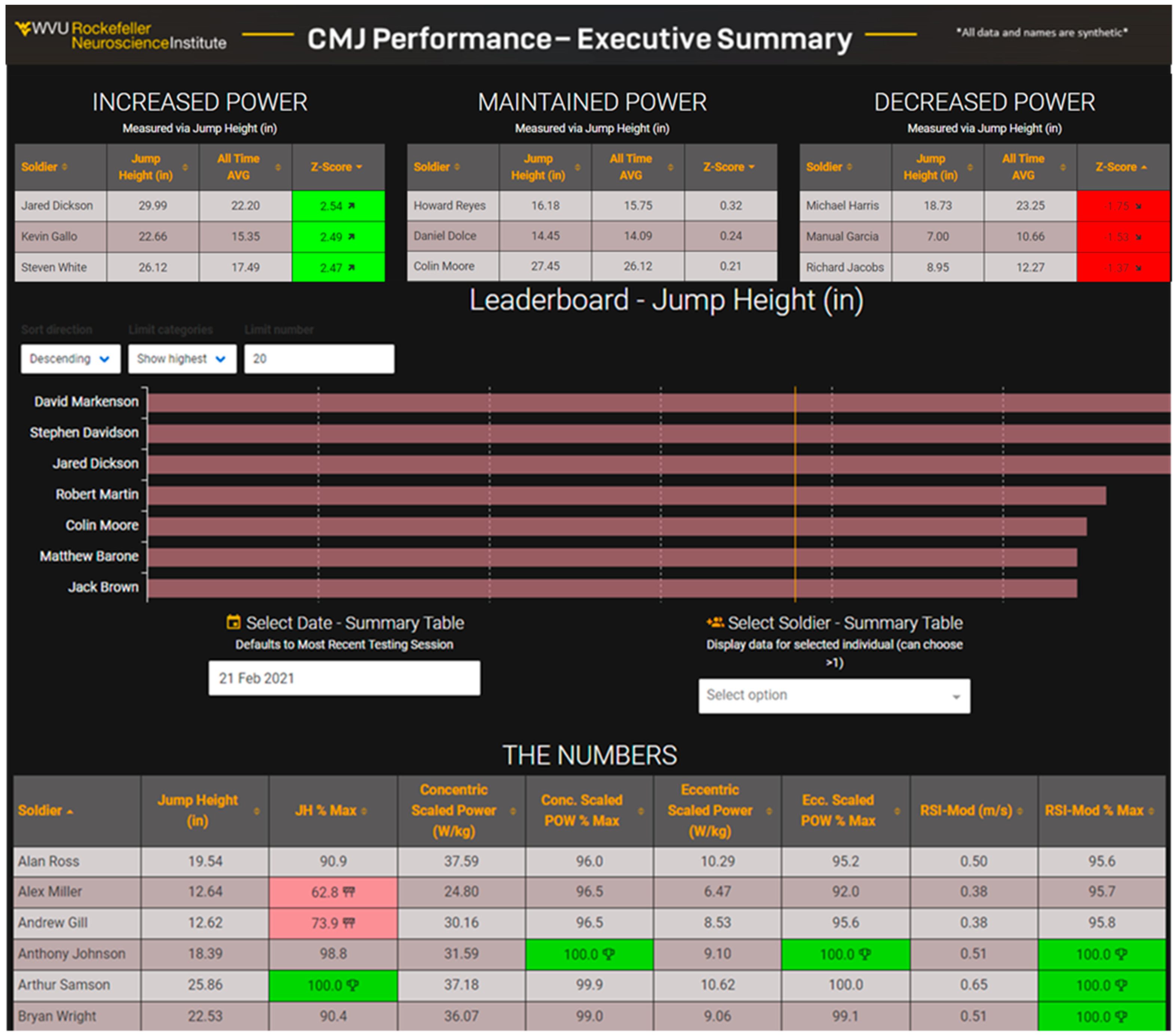
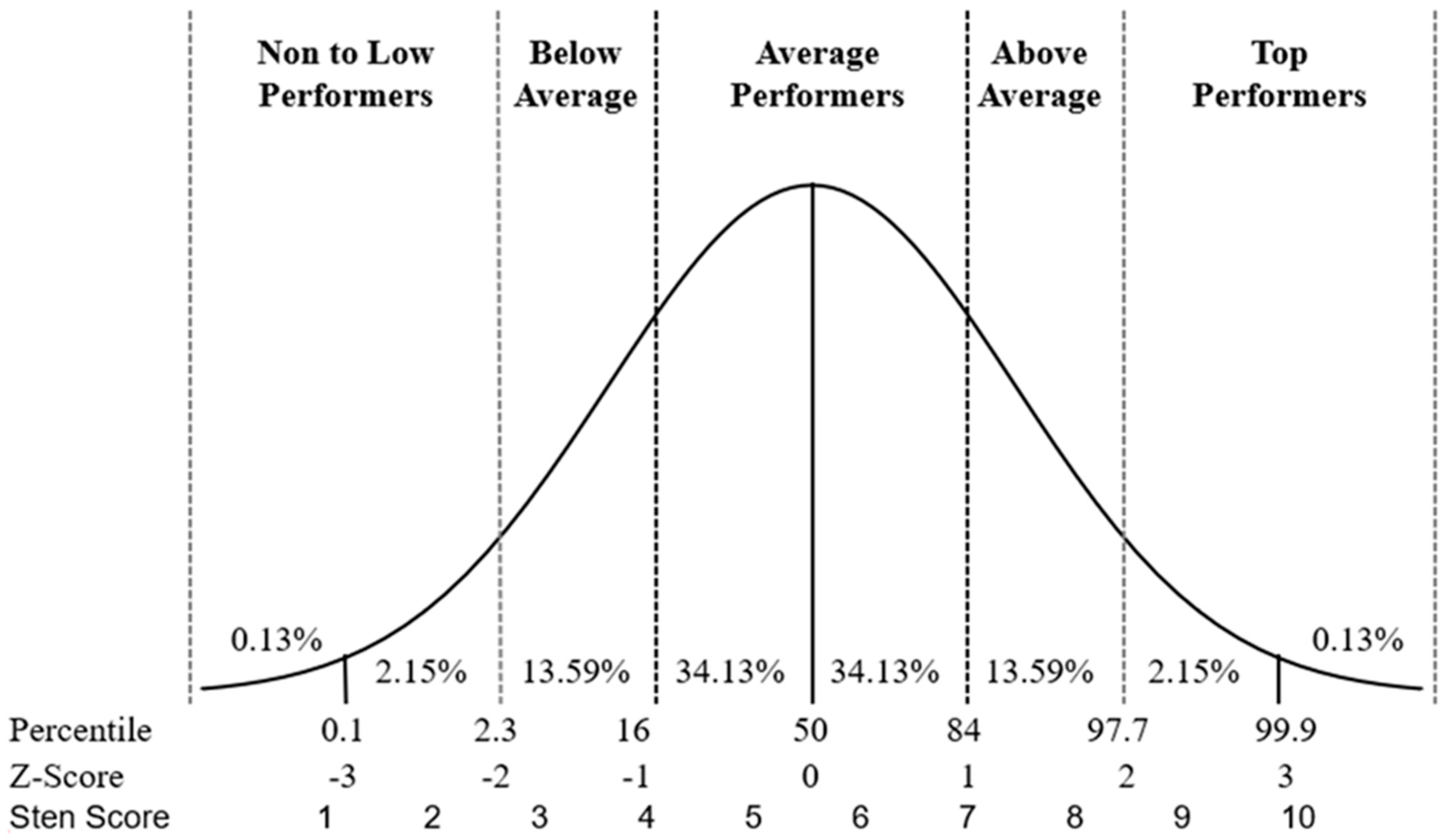


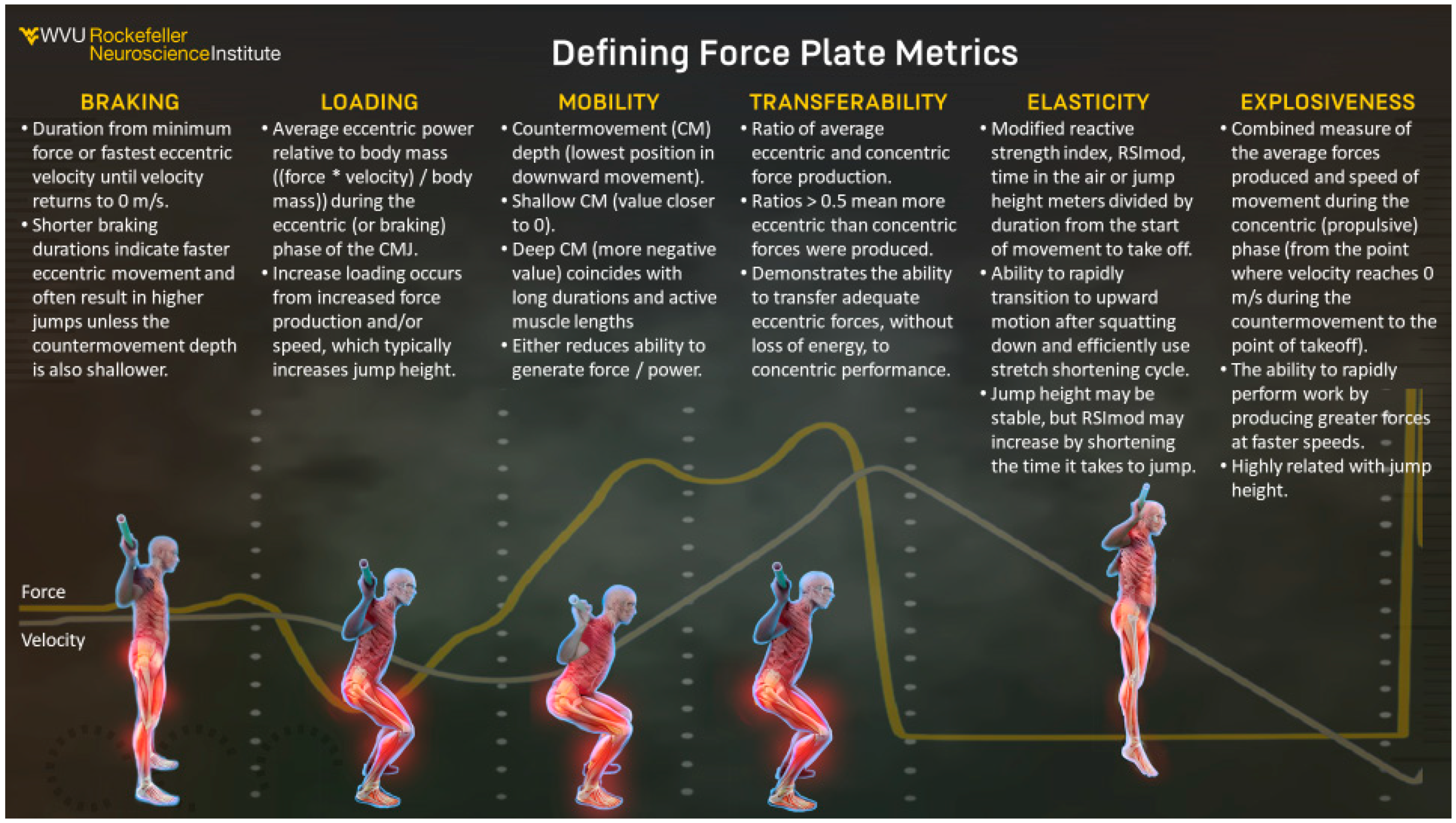
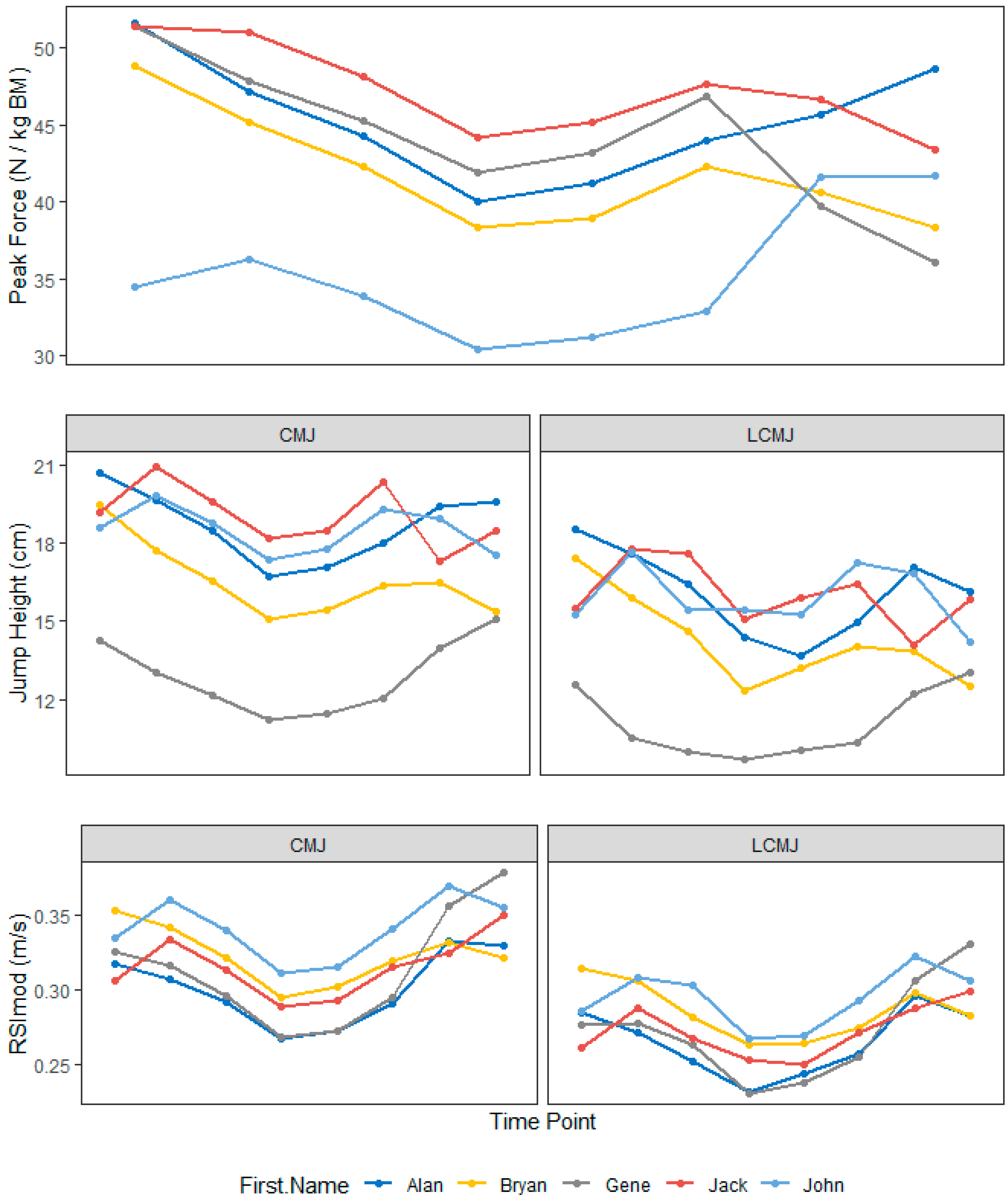

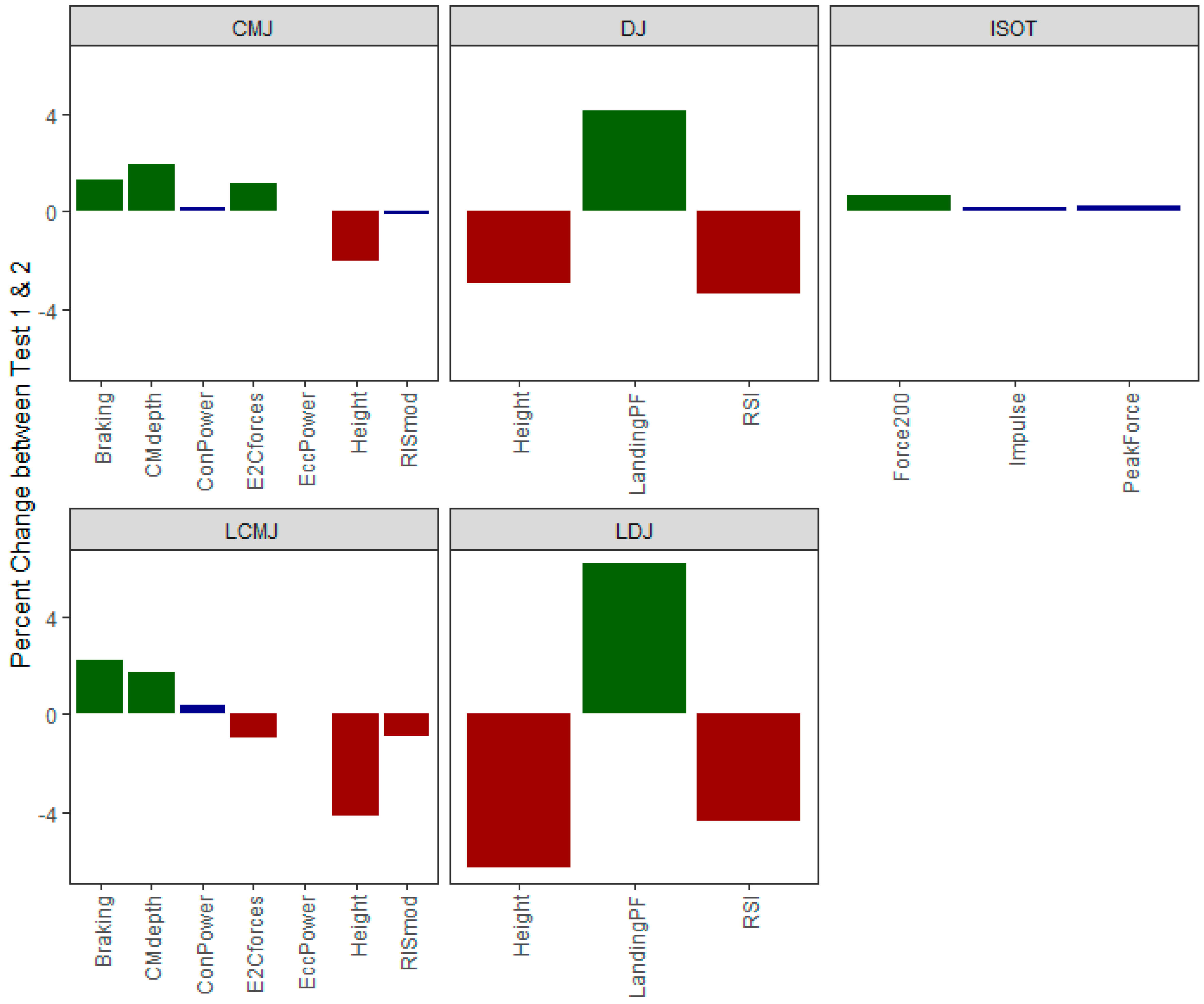

| Testing Purpose: | Strength, Power, Ability to Absorb Forces, Ability to Handle Loads | Strength, Power, Ability to Absorb Forces, Ability to Handle Loads | Strength, Power, Ability to Absorb Forces, Ability to Handle Loads | Power and Landing Forces |
|---|---|---|---|---|
| Time Commitment: | 30 min | 25 min | 5–10 min | 5–10 min |
| Equipment Required: | Force plate, squat rack for IMTP set up, plyometric box (30 cm), weighted vest or barbell | Force plate, plyometric box (30 cm), weighted vest or barbell | Force plate, weighted vest or barbell | Force plate, plyometric box (30 cm) |
| Example Warm-ups: | 5 min dynamic warmup exercises 1 set of 5: 20 kg Mid-thigh Clean Pull 3 sets of 5: 40 kg Mid-thigh Clean Pull | 5 min dynamic warmup exercises 5 CMJ at 50% effort 3 CMJ at 75% effort 2 CMJ at 100% effort | 5 CMJ at 50% effort 3 CMJ at 75% effort 2 CMJ at 100% effort | 5 CMJ at 50% effort 3 CMJ at 75% effort 2 CMJ at 100% effort |
| Example Testing Battery: | 2–3 CMJ trials 2–3 DJ trials 2–3 Loaded CMJ trials 2–3 Loaded DJ trials 2–3 IMTP trials | 2–3 CMJ trials 2–3 DJ trials 2–3 Loaded CMJ trials 2–3 Loaded DJ trials | 2–3 CMJ trials 2–3 Loaded CMJ trials | 2–3 CMJ trials 2–3 DJ trials |
| Firefighter | Metrics Above Group Average | Metrics Below Group Average | Training Recommendation |
|---|---|---|---|
| 1 | Movement strategies | Relative strength measures | Continue strength training, progressively add explosive exercise (i.e., plyometrics) |
| 2 | Strength and power measures | Additional strength and power programming | |
| 3 | Strength measures and CMJ performance Higher asymmetries | Drop jump performance and low reactive strength Countermovement Depth | Include explosive movements in the training program, and mobility work to improve movement compensation |
| 4 | Unloaded and loaded CMJ performance | Coaching to improve jump strategy, and velocity/power focused training |
| Training Phase | Testing Purpose | Testing Frequency | Test Types |
|---|---|---|---|
| Macrocycle | General Profiling | Annual 2× per year Pre-Post Deployment CPT/CFT | Maximal Isometric Strength Testing CMJ (Loaded and Unloaded) SJ (Loaded and Unloaded) DJ |
| Mesocycle | Training Adaptations | Contingent on Periodized Training BlocksTypically Every 4, 6, 8, or 12-Weeks | CMJ (Loaded and Unloaded) SJ (Loaded and Unloaded) DJ |
| Microcycle | Fatigue or Recovery/ Rehabilitation Monitoring | Weekly or Bi-Weekly | CMJ (Loaded and Unloaded) * SJ (Loaded and Unloaded) * DJ |
Publisher’s Note: MDPI stays neutral with regard to jurisdictional claims in published maps and institutional affiliations. |
© 2021 by the authors. Licensee MDPI, Basel, Switzerland. This article is an open access article distributed under the terms and conditions of the Creative Commons Attribution (CC BY) license (https://creativecommons.org/licenses/by/4.0/).
Share and Cite
Merrigan, J.J.; Stone, J.D.; Martin, J.R.; Hornsby, W.G.; Galster, S.M.; Hagen, J.A. Applying Force Plate Technology to Inform Human Performance Programming in Tactical Populations. Appl. Sci. 2021, 11, 6538. https://doi.org/10.3390/app11146538
Merrigan JJ, Stone JD, Martin JR, Hornsby WG, Galster SM, Hagen JA. Applying Force Plate Technology to Inform Human Performance Programming in Tactical Populations. Applied Sciences. 2021; 11(14):6538. https://doi.org/10.3390/app11146538
Chicago/Turabian StyleMerrigan, Justin J., Jason D. Stone, Joel R. Martin, William Guy Hornsby, Scott M. Galster, and Joshua A. Hagen. 2021. "Applying Force Plate Technology to Inform Human Performance Programming in Tactical Populations" Applied Sciences 11, no. 14: 6538. https://doi.org/10.3390/app11146538
APA StyleMerrigan, J. J., Stone, J. D., Martin, J. R., Hornsby, W. G., Galster, S. M., & Hagen, J. A. (2021). Applying Force Plate Technology to Inform Human Performance Programming in Tactical Populations. Applied Sciences, 11(14), 6538. https://doi.org/10.3390/app11146538








